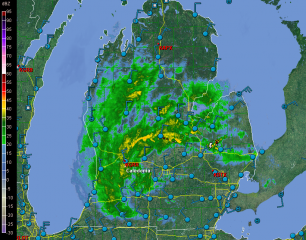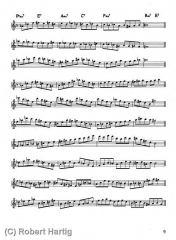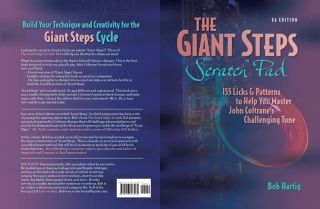Back in my heyday as a college music student, I had a subscription to Down Beat magazine. I was a Down Beat junkie, and among the things I eagerly looked forward to each month were the record reviews. It has been a long time since I’ve riffed through a Down Beat, but I just peeked online, and the legendary jazz magazine looks to have successfully made the leap into the digital age and appears to be going strong. Moreover, I’m pleased to see that the recording reviews are still a mainstay for the publication—and why not? With links to Amazon, CD Baby, and iTunes, they ought to pack plenty of marketing muscle.
But what happened to the ratings? Looking at these online “Editor’s Picks,” I don’t see the old, familiar five-star system that I knew and loved. Has that gone away, or am I just missing something? Boy, am I out of the loop. Back in the 1980s, every album got a rating of anywhere from zero stars (Translation: “This CD sucks so badly, your room may implode”) to five stars (“Transcendent. The artist qualifies for sainthood”). How could I forget?
I wrote the following piece years ago as a spoof of a Down Beat review by a hard-bitten jazz critic giving his take on the first album by crumpophone wizard Irving Freen. Rarely does the F# crumpophone attain the splendid heights to which Irving takes it. For that matter, few are those who play the crumpophone or have even heard of it. There are reasons why—but I’ll let you find out for yourself. Read on.
—————————-
CD REVIEW
Artist: Irving Freen
Album Title: Aaaarrrggh!
Rating:
Let me say up front that I’m not easily impressed. What passes for jazz today is pabulum to the ears of one suckled on the fiery wine of hard bop, and the current crop of artists has for the most part had little to say that hasn’t been said before and said better.
So when I first heard of a young lion by the name of Irving Freen, my gut response was indifference.
“Ya gotta hear this guy,” they told me. “He’s incredible!”
Yeah, right. “Okay, so let’s hear Mr. Incredible’s CD,” I grunted, yawning politely to conceal my boredom.
I changed my attitude as soon as I heard the first cut.
Irving Freen is a crumpophone player of the highest order. Of the few who have wrestled with the quirky instrument, Freen is the undisputed king. Flawless technique, awesome creativity, and a haunting tone that reminds me at once of the cry of a curlew and the mating bellow of a bull hippo . . . it’s hard not to wax rhapsodic over this thrilling new artist. Where has he been up till now, I wondered?
Well, for one thing, purchasing the space necessary to play the crumpophone. Probably one reason the instrument has had so few practitioners is that most musicians simply can’t afford the acreage. The F# crumpophone humps over approximately two-and-a-half acres of real estate. Toss in scaffolding, a small shed for generators, and a neckstrap, and you’ve got one pricey instrument. And that’s not even counting the eighty-acre buffer zone required by law to keep the neighbors from complaining. Or the manpower involved in getting everything into a gig bag in time for rehearsal.
Then there’s the matter of expression. It’s hard to forge a truly compelling voice on an instrument with a range of only half an octave. Freen has conquered this limitation by augmenting his tonal palette with a remarkable series of “found sounds,” ranging from screams and howls that arise spontaneously whenever he gets his lips stuck in the mouthpiece, to assorted bird songs and animal calls provided by numerous sparrows, chipmunks, owls, elk, frogs, space aliens, and other life forms that wander into any of the horn’s nine bells and get lost in the mile-and-a-half of tubing.
Freen has also met the technical difficulties of the crumpophone with astonishing ingenuity. The spacing of the keys at thirty-foot intervals has long posed a problem for crumpophone players, who have never been able to improve their technique beyond the speed with which they can sprint from one key to the next. This limitation has made tempos above 4mm impractical and is the reason crumpophonists prefer ballads to bebop.
Freen, however, has met and mastered the challenge, paving the way for a new order of crumpophonist. Directing a powerful stream from a fire hose, Freen is able to shift pressure instantly from one key to the next without moving from his position, achieving a dexterity hitherto considered impossible. Not only so, but by using more than one hose, he is able to depress multiple keys, expanding the capabilities of the horn by a breathtaking three notes. Since these notes lie seven octaves above the normal range of the horn, they are unfortunately well beyond the realm of human hearing; however, they do allow the crumpophone to double as a highly effective dog whistle.
Well, all this is fine, you say, but can the man play?
Do bears eat popes in the woods?
Just listen to Irving Freen’s first cut on this album. “Ground Midnight” ought to convince the most skeptical listener that here is a crumpophonist who knows his way around a ballad. Granted, it would be nice to hear a crumpophonist who knows his way through a ballad, instead of sidestepping things like chord changes and well-connected lines. Still, “Ground Midnight” is instructive to anyone who wants to find out just how far a single note held for an entire tune can take the listener into the realms of sheer, soul-dripping expressiveness. Not too far, it turns out—not so far, say, as the sound of a blown tire flapping on the highway—but still well beyond where other crumpophonists have ever gone.
Having demonstrated his way with a ballad, Freen next gives us a taste of his “new music” chops. “Come Out With Your Hands Up!” is an apt name for the foray into frenzy that is cut number two. Here is well-organized pandemonium at its best, as the crumpophonist delves into his seemingly inexhaustible found-sound storehouse.
Against a backdrop of swirling bop harmonies, Freen delivers a masterful, almost overwhelming barrage of bent notes, cacophony, screams, animal noises, explosions, machine gun fire . . . all ripping along at the inconceivable tempo of 400 beats per minute and climaxing with an exceptionally effective howitzer bombardment. The sound of rending lumber is a brilliant touch, capturing the poignant moment when Freen’s pole barn is blown to pieces by a cleverly aimed note.
The arrival of the police provides a timely and sensitive vocal element. A command barked through a megaphone—subtle, yet crisp and authoritative in the background—suggests the origin of the tune’s title. The shattering-glass effect was achieved by the tasteful introduction of tear gas canisters into the sound mix through the living room window.
If I have one complaint, it’s a minor one—a slight muddiness to the sound at the precise point where the door is broken down. It kept me from fully enjoying Freen’s ensuing scuffle with the SWAT team before being ultimately dragged away. Still, this is unquestionably a five-star performance, and Freen is to be congratulated as soon as he’s allowed to receive visitors.
Incidentally, the above explains the brevity of this CD. Fifteen minutes is admittedly not standard album length, and for that reason some may balk at the price. The truly discriminating, however, will consider $29.99 a trifling sacrifice to pay for a taste of crumpophonery at its finest. Those who like their jazz served hot with adrenaline will look forward to the next offering from this young firebrand. Don’t hold your breath, though—I’ve a hunch it won’t be coming any time soon.






